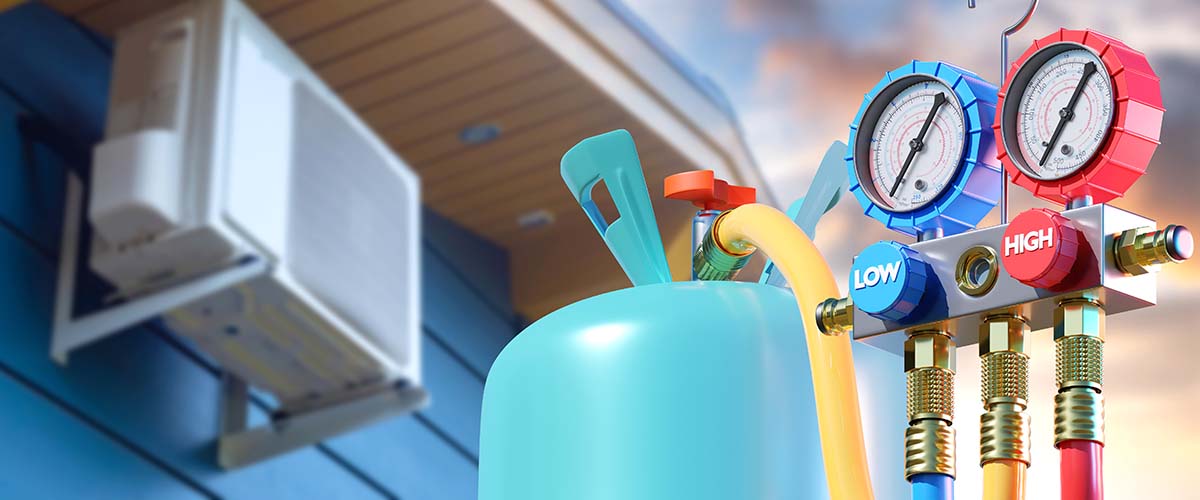The air feels warmer and heavier even though the thermostat says “Cool.” The vents whisper, but the air coming out is barely cool, and the outdoor unit clicks on with that familiar hum, then seems to give up. A neighbor told you it might be “low on Freon,” and now you’re wondering whether that’s even a thing anymore and what you’re supposed to do about it in the middle of a sticky evening. Let’s walk through whether air conditioners still use Freon, what that means for you, and how to keep your home comfortable without going in circles. It’s a simple process, and we’re here to guide you every step of the way.
Understanding Air Conditioner Freon
“Freon” is a brand name most people use for R-22, the old refrigerant that once filled many home air conditioners. The catch: The U.S. stopped producing and importing new R-22 in 2020 because it’s harmful to the ozone layer. That doesn’t mean your older system suddenly stopped working; it just means that replacement R-22 now comes from recycled/recovered supplies and is more expensive. If your system was installed after about 2010, there’s a good chance it uses something else—commonly R‑410A (often labeled “Puron”). Newer equipment is transitioning to lower-GWP refrigerants, such as R-32 or R-454 B.
Here’s the key: refrigerant lives in a closed loop. You don’t “use it up.” If your system needs a top‑off, there’s a leak somewhere. You can check your outdoor unit’s data plate (usually a silver sticker on the condenser) to see the refrigerant type, such as R-22 or R-410A. Don’t mix refrigerants, ever. Using the wrong refrigerant can damage your system and even pose a safety risk. Don’t try to refill AC Freon yourself; it requires EPA-certified technicians with the proper tools. Your job is to notice the symptoms early and prevent R22 leaks from worsening.
Quick Fixes to Try First
Before assuming refrigerant trouble, address the easy fixes. Start indoors: pop in a fresh air filter. If it’s gray and fuzzy, airflow is strangled, and coils can ice over. Set your thermostat to Cool, with the fan on Auto, and lower the setpoint by a couple of degrees. Listen—do you hear the indoor blower? A soft whoosh is good. A click followed by silence points toward a power or safety switch.
Check your breaker panel for a tripped AC breaker. Outside, make sure the disconnect switch is fully in place. Clear leaves and grass clippings from the condenser. Turn the power off, then gently rinse the coil with a garden hose. Light spray only. If you see frost on the big copper line or the indoor coil, turn the system off and run the fan only for 60–90 minutes to thaw.
Check the condensate drain outside; if it’s dripping steadily, that’s great. If not, a clog might be tripping a float switch. A quick vacuum on the drain line outside (shop vac) can restore flow. Finally, open supply vents and move furniture off returns. If, after all this, the air is still lukewarm or you hear hissing, it’s time to pause and call for help. These common air conditioning problems often have simple solutions when caught early.
Prevention and Maintenance
Air conditioners are like people in August—they do better with room to breathe. Keep 18–24 inches of open space around the outdoor unit. Trim shrubs, lift vines, and don’t lean tools or boards against the cabinet. Change filters regularly—monthly in peak season, especially if you have pets or dust, or every 60–90 days otherwise. A clean filter smells like cardboard and cotton. A dirty one smells like the attic and gives that dusty blast when the system kicks on.
Rinse the outdoor coil gently in spring and mid‑summer. Pour a half-cup of white vinegar into the condensate line access (usually located near the indoor unit) once a month to discourage algae growth. Keep return grilles clear, and don’t close more than one or two supply vents—starving airflow can cause coils to ice up. If you suspect a small leak (an oily smudge on copper lines, faint hissing, or performance that fades over weeks), have it checked early; small leaks can become major issues at the worst times.
I schedule professional tune‑ups twice a year. On a sweltering day last July, a quick tune‑up caught a failing capacitor at a neighbor’s place before it stranded them with warm air all weekend. And if your system still runs on R22 refrigerant and is over 12–15 years old, it’s wise to start planning. Not an emergency—just a budget line and a conversation about options. Our comprehensive specialist guide can help you understand your system better and make informed decisions.
When Will You Need Professional Help?
Call a pro when:
- You’ve done the basics, and the air is still warm.
- The outdoor unit runs, but the lines don’t get cold or sweat.
- You see ice on the coil hours after thawing, or it keeps re‑freezing.
- There’s a steady hiss, gurgle, or bubbling noise near the indoor coil.
- Your energy bill jumps, and the house won’t hit the setpoint.
Licensed techs have gauges, leak detectors, and scales to measure refrigerant properly. If you have an R-22 system and it’s leaking, topping it off is a temporary solution—expensive and short-lived. A reputable technician will discuss the benefits of repair versus replacement. Coil leak? Sometimes repairable, but it depends on the item’s age and availability. Compressor failure on an R‑22 unit? Often better to replace the system. Retrofitting R‑22 equipment to other refrigerants can create performance and reliability issues; most manufacturers don’t endorse it.
For newer systems using R-410A or the latest low-GWP refrigerants, repairs are more straightforward, and refrigerant is more readily available. Ask about system health, not just “adding gas.” Also, ask about rebates or tax incentives; a higher‑efficiency heat pump might not be as costly as you think once credits are applied. In a pinch, I keep a small window unit in the shed—saves a night of sweaty tossing if a part takes a day to arrive, especially here in Milledgeville, Georgia. When facing major issues, knowing whether you need repairs or replacement can save you time and money.
Common Questions
Do they still make Freon (R‑22)?
No. Production and import ended in 2020. Only recycled/recovered R‑22 is available, which makes it expensive.
Can I just get an AC Freon refill every summer?
Technically you can, but you shouldn’t. A system that needs refrigerant has a leak. Topping off without fixing the leak wastes money and risks compressor damage—and it’s illegal for anyone without a license to handle refrigerant. Many issues require professional repairs to ensure proper and safe operation.
How do I know what refrigerant I have?
Check the outdoor unit’s data plate. It will list R-22, R-410A, or another type of refrigerant. If it says “Puron,” that’s R‑410A.
Is it worth fixing an older R‑22 system?
For minor electrical issues, often yes. For refrigerant leaks or major components like compressors, replacement usually makes more sense, given the cost of R-22 and the efficiency gains from new equipment. Quality AC repair services can help you evaluate your options.



